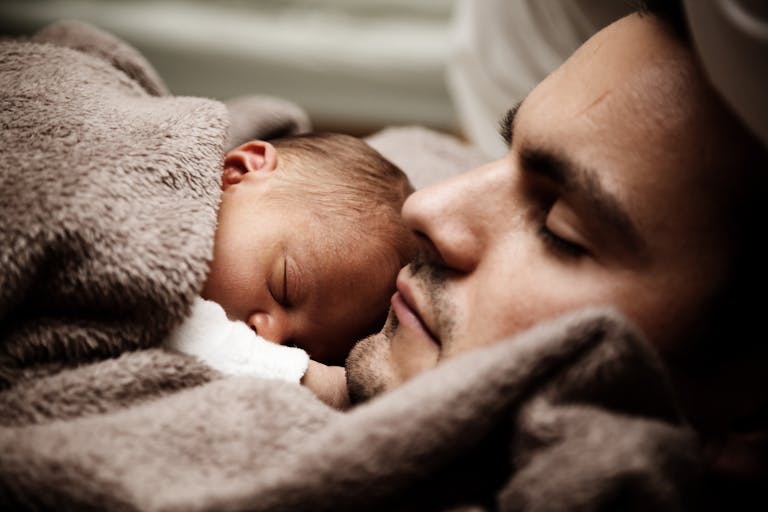Welcoming a newborn into your life can be exhilarating, overwhelming, and full of questions that tug at the edge of every parent’s mind. What does a typical day look like once you bring your newborn home? How do sleep, feeding, and comfort intersect in those early, hazy weeks? Concerns may quickly arise: Is your newborn gaining enough weight? Is all this crying expected, or could there be a problem? Sleep seems elusive, advice abounds, and everything—feeding, diapers, even the first bath—feels new. This journey blends science and instinct, vulnerability, and strength. Today, let’s unravel the realities of newborn care, sleep, development, and family transition—anchoring each point with up-to-date evidence from the fields of pediatrics, developmental science, and infant health. Practical solutions await, based on both best-practice clinical recommendations and the real, lived experience of families.
What Defines a Newborn? Physical Appearance, Immediate Adaptation, and First Concerns
Understanding the term newborn offers an entry point into the mysterious, rapidly evolving world of early infancy. This stage—medically known as the neonatal period—covers the first 28 days after birth. Just four weeks, but a whirlwind of physiological adjustments: lungs learn to breathe air, the digestive system figures out feeding, the skin adjusts from fluid-filled womb to air. A newborn’s appearance can be bewildering: a head proportionally large with flexible fontanelles (those famous soft spots), a body sometimes coated with vernix or lanugo, and mottled, blue-tinged extremities that gradually pinken as circulation improves. Average newborn weight ranges between 2.5 to 4.5kg (5.5–10lbs), with a typical length of 48-53cm—but don’t be surprised if your baby is a little outside that range. Every birth story is specific, shaped by genetics, gestation, and birth circumstances.
Perhaps your newborn’s skin is peeling, particularly on the hands and feet. No need to worry—this is natural as the vernix absorbs. Early reflexes, like the Moro (startle), grasp, or rooting reflex, offer a glimpse into the healthy functioning of your baby’s nervous system. These primitive reflexes—automatic and often dramatic—are not just quirks, but roadmaps of a maturing brain, to be replaced by purposeful movements as weeks pass.
Preparing Home and Heart: Baby Gear, Sibling Bonds, and Safe Sleep
Equipping your space for a newborn isn’t about accumulation, but about safety and comfort. Start with a firm crib mattress, no pillows or thick blankets—safe sleep, always, is about reducing risk. Diapers, baby wipes, soft clothing, and clean feeding supplies are necessities, not luxuries. One can’t overstate the importance of hand hygiene; newborn immune systems are still learning their lines, and regular washing is an excellent shield.
A room temperature around 19°C (66°F)? Yes, that scientific recommendation matters: avoiding overheating is linked to decreased risk of Sudden Infant Death Syndrome (SIDS). Light layers, a well-fitted sleep sack, and a comfort object placed at the feet—never near your newborn’s face—define modern best practice.
Don’t forget pet routines and sibling transitions. Involve older children (perhaps handing a wipe, helping choose an outfit, or simply gentle introductions). Consistency in their daily rhythms can ease their adjustment, making the arrival of the newborn a family evolution, not a disruption.
Early Development: Senses, Movement, and Communication
You might look into your newborn’s gaze and wonder—what do they see? Science tells us that vision is initially focused about 20–30cm away, with a preference for contrasts and faces. This is not random: the proximity aligns perfectly with the distance to a parent’s face during feeding or cuddling. Hearing, however, is already tuned in. Familiar voices, quietly sung songs—even the modulation of syllables—have a measurable calming effect. Touch, too, plays an outsized role: skin-to-skin contact not only soothes, but regulates heart rate, body temperature, and supports early brain development. Studies show that gentle massage and caressing help newborns gain weight and manage stress.
Crying, which may peak around six weeks, serves as a full-bodied communication system. Not all cries signal hunger; sometimes it is discomfort, sometimes the raw challenge of adjusting to a sensory-rich environment. Responding consistently doesn’t “spoil” your newborn—it builds their sense of safety and lays the scaffolding for emotional resilience.
Sensory Stimulation and Early Play
You may wonder whether newborns need play, or if it’s all about feeding and sleeping. The answer? Even a day-old newborn benefits from carefully chosen sensory input. Try contrasting black-and-white images, a simple mobile, or even your own face. Gentle touches, lullabies, shatterproof mirrors, and brief, awake tummy time all count as “play”—even if your newborn responds only with a blink or a brief turn. Watch for cues: yawning, sudden fidgeting, or avert gaze signal overstimulation. Tummy time may last only a minute or two at first, but every attempt strengthens the neck and shoulders, helping prevent plagiocephaly (flat head syndrome).
Sleep in Newborns: Rhythms, Routines, and SIDS Prevention
Does it feel like your newborn sleeps endlessly, yet rest eludes you? That paradox speaks to the nature of neonatal sleep: up to 18–20 hours a day, often in short, unpredictable bursts. Wakeful stretches occur around feeding needs—hunger trumps drowsiness. Establishing a gentle bedtime routine—a warm bath, soft light, quiet song—helps your newborn learn the difference between day and night, even if consolidated sleep is weeks (or months) away.
Safety is paramount. Always place your newborn on their back, use a firm mattress, and keep soft objects clear from the sleep space. Swaddling is scientifically shown to diminish the startle reflex for some babies, but must be done safely: never restrict hip movement, and cease swaddling when your newborn shows any sign of rolling over.
Room-sharing (but not bed-sharing) is recommended for the first six months, helping you attend quickly to your newborn while reducing sleep-related risks. Smoke exposure? Best eliminated altogether; we know it increases the risk of SIDS and respiratory issues.
Feeding: Breast, Bottle, and The Rhythm of Demand
Nutrition for your newborn—breast milk or infant formula—should be tailored to your family’s needs. The number one rule: feed on demand. Typical newborns eat 8–12 times per day, signaling readiness with rooting, hand-sucking, or fussiness. Satiation is marked by turning away, open hands, and relaxed limbs.
Breastfeeding brings immune and nutritional benefits, but formula is nutritionally complete if that route is chosen. Sterile preparation is vital with formula, since new immune systems are vulnerable to bacteria. Vitamin D supplementation (400 IU daily) is advised for all breastfed newborns and formula-fed infants drinking less than 32oz daily.
Digestive development is ongoing, so spit-up is common and rarely concerning. Hold your newborn upright after feeds, and burp between sides or bottle ounces. Flat or inverted nipples can warrant support—tools like breast shells or nipple shields are options, and your care team or lactation consultant can provide hands-on, nonjudgmental troubleshooting.
During growth spurts, newborns may feed noticeably more for a day or two—a normal, healthy sign. When in doubt about intake, weight, or hydration, your pediatrician is your best resource.
Living Daily Life: Flexible Routines, Self-Care for Parents
Life with a newborn flows in cycles: feed, burp, change, soothe, sleep—repeat. Rigid schedules rarely fit this phase, so flexibility is your friend. Rest when your newborn sleeps, keep wipes, diapers, and a spare change of clothes within easy reach for nighttime changes, and don’t hesitate to accept (or ask for) support. Night feeds can be softened with dim lighting and a calm, unhurried routine.
Sibling bonding thrives when older children are given small, meaningful roles. Pets may require gradual acclimatization—a walk alongside the stroller here, a treat after a supervised introduction there. Support groups for parents of newborns can be lifelines, offering evidence-backed advice, solidarity, and reassurance.
Core Newborn Care: Cord, Skin, and Diapering
Umbilical cord care? Simplicity is best: keep it dry, avoid unnecessary handling, and cleanse with warm water as needed. Redness or a foul smell may suggest infection—medical assessment is then necessary.
Bathing need not be daily—two or three times weekly is generally enough for newborn hygiene, using water at 37°C (98.6°F) and a fragrance-free cleanser. Cradle cap, toxic erythema, and transient newborn rashes usually resolve on their own; consult your doctor if any rash persists or looks concerning.
Diaper changes are frequent (8–10 times per day for most newborns); thorough cleaning and a barrier cream can help prevent diaper rash. Observe for redness, irritation, or unusual stool changes.
Medical Oversight: When to Worry, When to Observe
Early newborn checkups are rigorous: monitoring for appropriate weight gain, length, head circumference, and neurodevelopment. Vaccination begins at two months, but certain conditions—trouble breathing, a persistently yellow complexion (jaundice), blue lips, or poor feeding—demands prompt medical evaluation.
Breathing in newborns is often noisy or seems irregular; this is largely anatomical, driven by immature airways, but true respiratory distress should never be brushed aside. The newborn skull is adaptable, sometimes temporarily misshapen after delivery, but should gradually round out with time and positional changes.
Attachment, Bonding, and Emotional Growth
Bonding doesn’t have to be immediate or look magical. For most parents, it forms out of a series of tiny, repeated actions—skin-to-skin contact, gentle rocking, soft words, and eye contact. Infant massage, reading, and responding to your newborn’s cues enrich emotional security and lay pathways for communication and trust. Scientific studies show that consistent, responsive caregiving enhances neurodevelopment and strengthens lifelong attachment.
Myths, Realities, and Navigating Advice
Popular beliefs about newborns can mislead. Sleeping through the night is rare and shouldn’t be expected until later infancy. Feeding on demand aligns with physiological hunger cues; rigid schedules are outdated. Crying peaks and then subsides—responding warmly is not a sign of “weakness,” but emotional wisdom. Bonding is a journey, often shaped more by repetition than by the first magical moment after delivery.
Never shake your newborn, no matter how stressed or sleep-deprived you feel—if you need a break, place your baby safely in their crib and step away for a moment. Community and family support exist for a reason.
Parental Well-Being: Emotional Shadows and New Rhythms
Feeling emotionally raw, fatigued, or uncertain is a common reaction in newborn parenting. The so-called baby blues crest within two weeks and pass. Persistent sadness, trouble connecting with your newborn, or feeling hopeless might signal postpartum depression. Here, medical support, counseling, and compassionate connection are not just helpful—they are essential.
Rest, nutrition, kindness, and community matter as much for you as for your newborn. No textbook can anticipate every challenge, but every parent deserves reliable, evidence-based support.
Key Takeaways
- The newborn period—brimming with rapid transformation—demands both scientific understanding and patient flexibility.
- Safety, including safe sleep, on-demand feeding, and hygiene, cannot be overemphasized.
- Responding to your newborn’s cues fosters secure attachment and supports development.
- Crying, irregular sleep, and early confusion about routines are temporary; professional help is available when concerns arise.
- Emotional and practical support for parents benefits the whole family’s adjustment.
- Families can always access resources and expertise for tailored guidance—explore further with the Heloa app, which provides free health questionnaires and personalized parenting advice rooted in the latest evidence.
Your newborn is a singular, ever-changing presence—both delicate and astonishingly resilient. Trust evidence, trust your instincts, and know that with each day, you’re building not only their future, but yours as well.
Questions Parents Ask
How do you dress a newborn for sleep?
When dressing your newborn for sleep, comfort and safety always come first. You can start with a soft cotton bodysuit or onesie, then add a lightweight sleep sack if the room is cool. It’s generally advised to use one layer more than what an adult would be comfortable wearing in the same environment. Avoid hats, loose blankets, or anything that could cover your baby’s face to reduce the risk of overheating and support safe sleep. If you wonder about the temperature, touching your baby’s neck or chest is a simple way to see if they feel comfortable—not too hot or cold. Each newborn is unique, so adjusting layers as needed is totally normal. Rassurez-vous, babies don’t need to be bundled up unless the room is chilly.
What to do if my newborn has hiccups?
Hiccups are common and generally harmless for newborns. They often happen when babies eat quickly or swallow air, and they usually resolve on their own after a few minutes. If your baby seems comfortable, there is no need to do anything special. In case hiccups become frequent during feeding, taking breaks for gentle burping might help. Also, make sure your baby is feeding calmly and not swallowing an excess amount of air. Most importantly, hiccups do not cause distress to your baby, and they rarely indicate a health problem. If you ever notice that your baby seems uncomfortable or distressed during hiccups, seeking advice from a healthcare professional may bring you peace of mind.
How can I help my newborn if they seem congested?
Nasal congestion is quite common in newborns due to their tiny nasal passages. Keeping your baby’s head slightly elevated during sleep (by slightly tilting the mattress, not adding a pillow) and using a gentle saline solution with a bulb syringe can help clear mucus. Ensure the air in your baby’s room is not too dry; a cool-mist humidifier can be helpful, especially in winter. Avoid overusing nasal aspirators—gentle is key. If you notice signs of labored breathing, difficulty feeding, or persistent congestion, it is important to consult your pediatrician for reassurance and support. Remember, congestion in newborns often improves on its own as their airways adjust to the environment.










